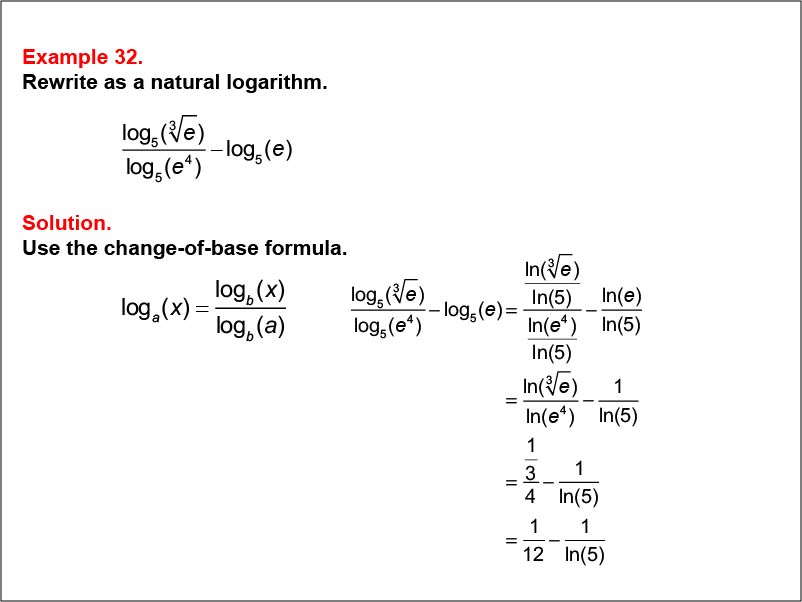
Display Title
Math Example: Laws of Logarithms: Example 32
Display Title
Math Example: Laws of Logarithms: Example 32

Topic
Logarithms
Description
This example demonstrates the application of the change-of-base formula to convert a complex expression involving logarithms with base 5 to a natural logarithm expression. The problem involves rewriting (log5(3√(e)) / log_5(e4)) - log5(e) using natural logarithms. The solution applies the change-of-base formula loga(x) = ln(x) / ln(a) to each term, resulting in (ln(3√(e)) / ln(e4)) - (ln(e) / ln(5)). This simplifies to (1/12 - 1) / ln(5), which further reduces to -11/12 ln(5).
This example showcases the application of multiple logarithmic properties and algebraic skills to simplify a complex logarithmic expression. It demonstrates how the change-of-base formula can be used to convert logarithms of different bases to natural logarithms, allowing for easier manipulation and simplification. Such problems help students develop a comprehensive understanding of logarithmic manipulation and enhance their problem-solving skills with advanced mathematical concepts.
By working through examples like this, students learn to approach multi-step logarithmic problems systematically, applying various logarithmic properties and algebraic skills. This type of problem-solving is crucial for success in advanced mathematics, particularly in calculus and differential equations where logarithmic and exponential functions play a significant role.
Teacher's Script: Let's tackle this complex example involving logarithms with base 5 and the constant e. We start with (log5(3√(e)) / log5(e4)) - log5(e). To convert this to natural logarithms, we'll apply the change-of-base formula to each term. This gives us (ln(3√(e)) / ln(5)) / (ln(e4) / ln(5)) - ln(e) / ln(5). The ln(5) terms in the fraction cancel out, leaving us with ln(3√(e)) / ln(e4) - ln(e) / ln(5). Now, let's simplify further. 3√(e) is e(1/3), so we have (ln(e(1/3)) / ln(e4)) - ln(e) / ln(5) = (1/3) / 4 - 1 / ln(5) = 1/12 - 1 / ln(5). We can write this as (1/12 - 1) / ln(5) = -11/12 ln(5). This example shows how we can use the change-of-base formula and properties of logarithms to simplify complex expressions involving different bases and the constant e.
For a complete collection of math examples related to Logarithms click on this link: Math Examples: Laws of Logarithms Collection.
| Common Core Standards | CCSS.MATH.CONTENT.HSF.BF.B.5 |
|---|---|
| Grade Range | 9 - 12 |
| Curriculum Nodes |
Algebra • Exponential and Logarithmic Functions • Laws of Logarithms |
| Copyright Year | 2013 |
| Keywords | logarithms, laws of logarithms |